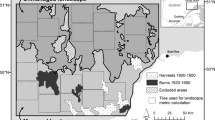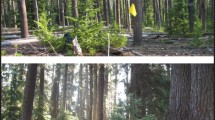Abstract
As a consequence of land abandonment and marginalization, open areas and traditionally managed wood pastures are disappearing from many alpine valleys. Landscape and stand scale dynamics were analyzed in two neighboring inner valleys of central Italian Alps (Valmalenco, SO) dominated by larch (Larix decidua Mill.) forests and experiencing different historical land use intensities. Land cover mapping obtained from object-oriented analysis of aerial photographs was used to quantify land cover changes between 1961 and 2003. Spatial statistics were used to quantify landscape patterns, and intensive sampling in permanent plots was employed to perform point pattern analysis at the stand scale. Expansion of forested area at the expense of wood pastures was the main land cover transition observed. Differences in land use intensities were responsible for different patterns at the landscape scale: (1) heavier grazing and human pressure created a more diverse and fragmented mosaic of meadows, open woodlands, forests and wood pastures, (2) lower human impact favored a more homogeneous and stable system. A decline in grazing pressure in the late 1970s favored the establishment of larch and spruce in a clustered pattern, typical of the subalpine belt. Subalpine wood pastures, likewise many other semi-natural environments, are in danger of disappearing and lose their productive and cultural characteristics, because they are developing into more closed and dense stands.



Similar content being viewed by others
Abbreviations
- LCC:
-
Land cover class
- LU:
-
Livestock units
References
Aakala T, Kuuluvainen T, De Grandpré L, Gauthier S (2007) Trees dying standing in the northeastern boreal old-growth forests of Quebec: spatial patterns, rates, and temporal variation. Can J For Res 37:50–61
Adams SN (1975) Sheep and cattle grazing in forests: a review. J Appl Ecol 12:143–152
Albert CH, Thuiller W, Lavorel S, Davies ID, Garbolino E (2008) Land-use change and subalpine tree dynamics: colonization of Larix decidua in French subalpine grasslands. J Appl Ecol 45:659–669
Antrop M (2005) Why landscapes of the past are important for the future. Landsc Urban Plan 70:21–34
Axelsson AL, Östlund L (2001) Retrospective gap analysis in a Swedish boreal forest landscape using historical data. For Ecol Manag 147:109–122
Bätzing W, Perlik M, Dekleva M (1996) Urbanization and depopulation in the Alps: an analysis of current social–economic structural changes. Mt Res Dev 16:335–350
Baudry J (1991) Ecological consequences of grazing extensification and land abandonment: role of interactions between environment, society and techniques. Options Méditerranéennes 15:13–19
Bergomi M (2006) Politica e Amministrazione in Valmalenco nell’Età Moderna. Società Storica Valtellinese, Sondrio
Bolliger J, Kienast F, Soliva R, Rutherford GN (2007) Spatial sensitivity of species habitat distribution patterns to scenarios of land-use change (Switzerland). Landsc Ecol 22:773–789
Bürgi M (1999) A case study of forest change in the Swiss lowlands. Landsc Ecol 14:567–575
Bürgi M, Gimmi U (2007) Three objectives of historical ecology: the case of litter collecting in Central European forests. Landsc Ecol 22:77–87
Cain D, Riitters K, Orvis K (1997) A multi-scale analysis of landscape statistics. Landsc Ecol 12:199–212
Chen J, Franklin J, Spies T (1992) Vegetation responses to edge environments in old-growth Douglas-fir forests. Ecol Appl 2:387–396
Cousins SAO, Lavorel S, Davies I (2003) Modeling the effects of landscape pattern and grazing regimes on the persistence of plant species with high conservation value in grasslands in south-eastern Sweden. Landsc Ecol 18:315–332
Del Favero R (2002) I tipi forestali nella Regione Lombardia. Cierre edizioni, Milano
Della Marianna G, Gusmeroli F, Puccio C (2004) Gli alpeggi della Comunità Montana Valtellina di Sondrio. Fondazione Fojanini, Sondrio
Didier L (2001) Invasion patterns of European larch and Swiss stone pine in subalpine pastures in the French Alps. For Ecol Manag 145:67–77
Dullinger S, Dirnböck T, Greimler J, Grabherr G (2003) A resampling approach for evaluating effects of pasture abandonment on subalpine plant species diversity. J Veg Sci 14:243–252
Garbarino M, Weisberg PJ, Motta R (2009) Interacting effects of physical environment and anthropogenic disturbances on the structure of European larch (Larix decidua Mill.) forests. For Ecol Manag 257:1794–1802
Gimmi U, Bürgi M, Stuber M (2008) Reconstructing anthropogenic disturbance regimes in forest ecosystems: a case study from the Swiss Rhone valley. Ecosystems 11:113–124
Goreaud F, Pélissier R (2003) Avoiding misinterpretation of biotic interactions with the intertype K12-function: population independence vs. random labelling hypotheses. J Veg Sci 14:681–692
Grace JB (1999) The factors controlling species density in herbaceous plant communities: an assessment. Perspect Plant Ecol Evol Syst 2:1–28
Griffith J, Martinko E, Price K (2000) Landscape structure analysis of Kansas at three scales. Landsc Urban Plan 52:45–61
Grossmann EB, Mladenoff DJ (2007) Open woodland and savanna decline in a mixed-disturbance landscape (1938 to 1998) in the Northwest Wisconsin (USA) Sand Plain. Landsc Ecol 22:43–55
Haase P (1995) Spatial pattern analysis in ecology based on Ripley’s K-function: Introduction and methods of edge correction. J Veg Sci 6:575–582
Haase P (2001) Can isotropy vs. anisotropy in the spatial association of plant species reveal physical vs. biotic facilitation? J Veg Sci 12:127–136
Lasanta-Martinez T, Vicente-Serrano SM, Cuadrat-Prats JM (2005) Mountain Mediterranean landscape evolution caused by the abandonment of traditional primary activities: a study of the Spanish Central Pyrenees. Appl Geogr 25:47–65
Lingua E, Cherubini P, Motta R, Nola P (2008) Spatial structure along an altitudinal gradient in the Italian central Alps suggests competition and facilitation among coniferous species. J Veg Sci 19:425–436
Lotwick HW, Silverman BW (1982) Methods for analysing spatial processes of several types of points. J Roy Stat SocB Met 44:406–413
Manning AD, Fischer J, Lindenmayer DB (2006) Scattered trees are keystone structures—Implications for conservation. Biol Conserv 132:311–321
Marañón T (1988) Agro-sylvo-pastoral systems in the Iberian peninsula: Dehesas and montados. Rangelands 10:255–258
Mast JN, Veblen TT, Hodgson ME (1997) Tree invasion within a pine/grassland ecotone: an approach with historic aerial photography and GIS modeling. For Ecol Manag 93:181–194
Mayer AC, Estermann BL, Stockli V, Kreuzer M (2005) Experimental determination of the effects of cattle stocking density and grazing period on forest regeneration on a subalpine wood pasture. Anim Res 54:153–171
Mayer AC, Stockli V, Konold W, Kreuzer M (2006) Influence of cattle stocking rate on browsing of Norway spruce in subalpine wood pastures. Agrofor Syst 66:143–149
McCune B, Grace JB (2002) Analysis of ecological communities. MjM Software Design, Gleneden Beach
McGarigal K, Marks BJ (1995) Fragstats: spatial pattern analysis program for quantifying landscape structure. General Technical Report PNW-GTR-351. USDA Forest Service, Pacific Northwest Research Station, Portland
Motta R, Lingua E (2005) Human impact on size, age, and spatial structure in a mixed European larch and Swiss stone pine forest in the Western Italian Alps. Can J For Res 35:1809–1820
Motta R, Nola P, Piussi P (2002) Long-term investigations in a strict forest reserve in the eastern Italian Alps: spatio-temporal origin and development in two multi-layered subalpine stands. J Ecol 90:495–507
Mountford EP, Peterken GF (2003) Log-term change and implications for the management of wood-pastures: experience over 40 years from Denny Wood, New Forest. Forestry 76:19–43
Naveh Z (1995) Interactions of landscapes and cultures. Landsc Urban Plan 32:43–54
Neel M, McGarigal K, Cushman S (2004) Behavior of class-level landscape metrics across gradients of class aggregation and area. Landsc Ecol 19:435–455
Neumann M, Starlinger F (2000) The significance of different indices for stand structure and diversity in forests. For Ecol Manag 145:91–106
Papanastasis VP (1997) Livestock grazing in Mediterranean ecosystems: an historical and policy perspective. In: Papanastasis VP, Peter D (eds) Ecological basis of livestock grazing in mediterranean ecosystems. European Commission, Brussels, pp 5–9
Peterken GF (1977) Habitat conservation priorities in British and European woodlands. Biol Conserv 11:223–236
Pinto-Correia T (1993) Threatened landscape in Alentejo, Portugal: the ‘montado’ and other ‘agro-silvo-pastoral’ systems. Landsc Urban Plan 24:43–48
Pinto-Correia T, Mascarenhas J (1999) Contribution to the extensification/intensification debate: new trends in the Portuguese montado. Landsc Urban Plan 46:125–131
Piussi P (2000) Expansion of European mountain forests. In: Price MF, Butt N (eds) Forest in sustainable mountain development: a state of knowledge report for 2000. CABI Publishing, Wallingford, pp 19–25
Piussi P, Farrell EP (2000) Interactions between society and forest ecosystems: challenges for the near future. For Ecol Manag 132:21–28
Plieninger T (2003) Effects of land-use history on size structure of holm oak stands in Spanish dehesas: implications for conservation and restoration. Environ Conserv 30:61–70
Rackham O (1998) Savanna in Europe. In: Kirby JK, Watkins C (eds) The ecological history of European forests. CABI, Wallingford, pp 1–24
Riitters K, O’Neill R, Hunsaker C, Wickham J, Yankee D, Timmins S, Jones K, Jackson B (1995) A factor analysis of landscape pattern and structure metrics. Landsc Ecol 10:23–39
Ripley BD (1977) Modeling spatial patterns (with discussion). J Roy Stat SocB Met 39:172–212
Schonenberger W (2001) Cluster afforestation for creating diverse mountain forest structures—a review. For Ecol Manag 145:121–128
Schulze E-D, Mischì G, Asche G, Börner A (2007) Land-use history and succession of Larix decidua in the Southern Alps of Italy—an essay based on a cultural history study of Roswitha Asche. Flora 202:705–713
Smit C, Béguin D, Buttler A, Müller-Schärer H (2005) Safe sites for tree regeneration: a case of associational resistance? J Veg Sci 16:209–214
Smit C, Pohl M, Buttler A, Freléchoux F (2009) Does the strength of facilitation by nurse shrubs depend on grazing resistance of tree saplings? Basic Appl Ecol 10:427–436
Società Agraria di Lombardia (1901) Atti della commissione d’inchiesta sui pascoli alpini. Società Agraria di Lombardia, Milano
Swetnam TW, Allen CD, Betancourt JL (1999) Applied historical ecology: using the past to manage for the future. Ecol Appl 9:1189–1206
Tasser E, Walde J, Tappeiner U, Teutsch A, Noggler W (2007) Land-use changes and natural reforestation in the Eastern Central Alps. Agric Ecosyst Environ 118:115–129
Tinker D, Resor C, Beauvais G, Kipfmueller K, Fernandes C, Baker W (1998) Watershed analysis of forest fragmentation by clearcuts and roads in a Wyoming forest. Landsc Ecol 13:149–165
Tischendorf L (2001) Can landscape indices predict ecological processes consistently? Landsc Ecol 16:235–254
Turner MG, Dale VH (1998) Comparing large, infrequent disturbances: what have we learned? Ecosystems 1:493–496
Van Uytvanck J, Maes D, Vandenhaute D, Hoffmann M (2008) Restoration of wood pasture on former agricultural land: The importance of safe sites and time gaps before grazing for tree seedlings. Biol Conserv 141:78–88
Vandenberghe C, Freléchoux F, Moravie M, Gadallah F, Buttler A (2007) Short-term effects of cattle browsing on tree sapling growth in mountain wooded pastures. Plant Ecol 188:253–264
Vera FWM (2000) Grazing ecology and forest history. CABI, Wallingford
Weisberg PJ, Lingua E, Pillai RB (2007) Spatial patterns of pinyon–juniper woodland expansion in central Nevada. Rangeland Ecol Manag 60:115–124
Acknowledgments
We thank Tiziana Stangoni and Floriano Lenatti for the logistical support and the Sondrio Province, and Istituto Geografico Militare for providing aerial images and geographic material. We also thank the Lombardy Region and the Sondrio Province for funding this research through the “Programma regionale di ricerca in campo agricolo 2004–2006” program and two anonymous referees for the valuable comments and contributions.
Author information
Authors and Affiliations
Corresponding author
Additional information
Communicated by J. Müller.
Rights and permissions
About this article
Cite this article
Garbarino, M., Lingua, E., Martinez Subirà, M. et al. The larch wood pasture: structure and dynamics of a cultural landscape. Eur J Forest Res 130, 491–502 (2011). https://doi.org/10.1007/s10342-010-0437-5
Received:
Revised:
Accepted:
Published:
Issue Date:
DOI: https://doi.org/10.1007/s10342-010-0437-5




